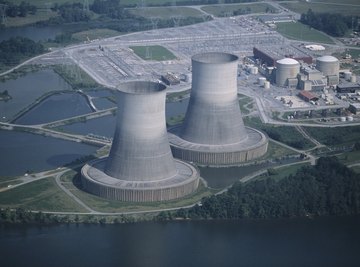
There are reasons for both using nonrenewable energy sources, such as fossil fuels, and for making a timely change in energy infrastructure to phase out their use. The reliability of energy derived from nonrenewable resources has provided an abundance of electricity and transportation for modern industrial nations, but concerns over the safety and sustainability of these power systems have also arisen.
The Difference Between Renewable and Nonrenewable Energy Sources
The main difference between renewable and nonrenewable energy is in the combustion and consumption of fuel. Nonrenewable energy sources burn oil and petroleum products such as gasoline, diesel fuel and propane to power a motor or electrical generator. Natural gas is also burned for heat and electricity, as is coal. Uranium ore is mined for use as fuel in fission reactors. All of these types of energy rely on fuels that are in finite supply. On the other hand, renewable energy sources such as solar, wind, water and geothermal all rely on collecting and converting the energy from naturally occurring phenomena that are relatively permanent and require no external fuel source.
Positive Aspects of Nonrenewable Energy
The energy infrastructure of much of the industrialized world is built to be powered by fossil fuel. According to Andy Darvill’s Science Site, nonrenewable fossil fuels provide 66 percent of the world’s electrical power, while satisfying 95 percent of our total energy needs. These include heating, transportation and electricity generation. This pre-existing infrastructure makes the use of fossil fuels much easier to adopt than renewable options, which require a greater initial investment. Photovoltaic solar cells or windmills, for example, may require substantial amounts of money to install. But an existing building can draw energy from an electrical grid and current natural gas pipelines without any new equipment. Nonrenewable energy sources are also able to generate a more constant supply of power, as long as their fuel exists. Renewable energy sources may rely on irregular or less frequent conditions, such as sunlight to generate solar power or wind to turn turbines.
Negative Impact of Nonrenewable Energy
One long-term concern with the use of nonrenewable resources is their lack of sustainability. Eventually, these limited resources will either run out or become too difficult to mine and our energy infrastructure will lack needed fuel sources. Of more imminent concern is the pollution generated by mining, refining and consuming these fuel sources. Harmful levels of air pollution are generated by coal power plants and power derived from burning petroleum products. Another concern in using these types of fuels is the potential for accidents, which can devastate both human life and the environment. While relatively rare, the results of an accident in a coal mine, on an oil rig or at a nuclear reactor are very severe.
References
About the Author
Rob Callahan lives in Minneapolis, where he covers style, culture and the arts for Vita.MN and "l'étoile Magazine." His work has earned awards in the fields of journalism, social media and the arts. Callahan graduated from Saint Cloud State University in 2001 with a Bachelor's degree in philosophy.
Photo Credits
Tom Brakefield/Stockbyte/Getty Images
